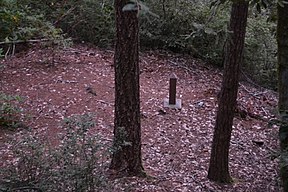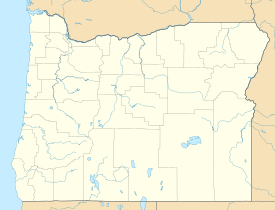Wheeler Ridge Japanese Bombing Site
| Wheeler Ridge Japanese Bombing Site | ||
|---|---|---|
| National Register of Historic Places | ||
|
Wheeler Ridge Japanese Bombing Site (2011) |
||
|
|
||
| location | Curry County , Oregon | |
| Coordinates | 42 ° 6 ′ 9 ″ N , 124 ° 9 ′ 10 ″ W | |
| NRHP number | 06000589 | |
| The NRHP added | July 6, 2006 | |
The Wheeler Ridge Japanese Bombing Site , also known as Mount Emily Bombing Site , is a military-historical site in the Rogue River National Forest east of the small town of Brookings in Curry County , Oregon . During the Lookout air raids by the Japanese Empire , the first air raid on the mainland of the United States took place here on September 9, 1942 .
Location and condition
The Wheeler Ridge Japanese Bombing Site is around 505 m above sea level. NHN in the upper third of a southern slope of the Wheeler Ridge as a terrain spur between two streams. There are full-grown trees and young trees as well as undergrowth. Two wooden billboards provide information about the historical background of the Wheeler Ridge Japanese Bombing Site, which is surrounded by primary forest of coastal redwoods and common douglas fir . Due to its remote location, the site where the bombs were dropped was only rediscovered in 1972 and was subsequently assessed and marked. Since then, the site has been visited more frequently, which has caused damage to the vegetation and the increased growth of scrub and young wood has increased the risk of forest fires . The maintenance and care of the Wheeler Ridge Japanese Bombing Site is the responsibility of the United States Forest Service .
history
During the Lookout air raids of World War II , the Imperial Japanese Navy dropped an incendiary bomb here on September 9, 1942 . Thus, the first air strike on the mainland of the United States took place at the Wheeler Ridge Japanese Bombing Site , followed 20 days later by another on a site in the Grassy Knob Wilderness in the Rogue River National Forest, which was never precisely located . The intention of this operation had been to set off large-scale forest fires and thereby tie up the enemy’s workers.
The pilot of the attack was Nobuo Fujita , who took off with a Yokosuka E14Y and an observer by catapult from the Japanese submarine I-25 , which lay off Cape Blanco, before sunrise . He used Cape Blanco Lighthouse as a landmark for the flight and the later rendezvous with I-25 . After Fujita had dropped the incendiary bomb in the early morning and watched it explode, he returned safely to the submarine. An American air raid on I-25 immediately thereafter caused only minor damage to the boat.
The local Aircraft Warning Service observation post , a civil air surveillance system set up during World War II using flight detectors, reported an aircraft of an unknown type at 0624 and detected smoke over the forest area at 12:20. Four hours later, an investigation team found an incendiary bomb to be the cause of the fire and was able to examine the bomb crater and recover fragments of the explosive device. In its report, the American military came to the conclusion that it was an incendiary bomb weighing almost 60 kg .
The location of the Wheeler Ridge Japanese Bombing Site fell into disuse after WWII. It was only rediscovered on August 10, 1972 by a search party led by photojournalist Bert Webber. In 1975, the Forest Service set up a marked path to the site and placed information boards there.
After the war, the Japanese pilot Fujita volunteered as an ambassador for peace and visited Oregon several times. At the Wheeler Ridge Japanese Bombing Site, he planted a sequoia sapling as a peace tree in 1992. Since its rediscovery, the site has been given the status of a symbol of international understanding , especially for American and Japanese veterans of the Pacific War .
In June 2004, archaeologists from the United States Forest Service thoroughly examined the site and found no fragments of the bomb. The Wheeler Ridge Japanese Bombing Site was listed as a memorial on the National Register of Historic Places on July 6, 2006 .
Individual evidence
- ↑ Kay Atwood: Wheeler Ridge Japanese Bombing Site: Registration Form . In: National Register of Historic Places database . National Park Service , September 10, 2004, accessed May 21, 2017 (English, 1.6 MB), p. 3.
- ↑ Kay Atwood: Wheeler Ridge Japanese Bombing Site: Registration Form . In: National Register of Historic Places database . National Park Service , September 10, 2004, accessed May 21, 2017 (English, 1.6 MB), p. 4.
- ↑ Kay Atwood: Wheeler Ridge Japanese Bombing Site: Registration Form . In: National Register of Historic Places database . National Park Service , September 10, 2004, accessed May 21, 2017 (English, 1.6 MB), p. 5.
- ↑ Kay Atwood: Wheeler Ridge Japanese Bombing Site: Registration Form . In: National Register of Historic Places database . National Park Service , September 10, 2004, accessed May 21, 2017 (English, 1.6 MB), pp. 8, 9.
- ↑ Kay Atwood: Wheeler Ridge Japanese Bombing Site: Registration Form . In: National Register of Historic Places database . National Park Service , September 10, 2004, accessed May 21, 2017 (English, 1.6 MB), pp. 12, 13.
- ↑ Kay Atwood: Wheeler Ridge Japanese Bombing Site: Registration Form . In: National Register of Historic Places database . National Park Service , September 10, 2004, accessed May 21, 2017 (English, 1.6 MB), pp. 14, 15.
- ↑ Kay Atwood: Wheeler Ridge Japanese Bombing Site: Registration Form . In: National Register of Historic Places database . National Park Service , September 10, 2004, accessed May 21, 2017 (English, 1.6 MB), p. 17.
- ↑ Kay Atwood: Wheeler Ridge Japanese Bombing Site: Registration Form . In: National Register of Historic Places database . National Park Service , September 10, 2004, accessed May 21, 2017 (English, 1.6 MB), pp. 24, 25.
- ↑ Kay Atwood: Wheeler Ridge Japanese Bombing Site: Registration Form . In: National Register of Historic Places database . National Park Service , September 10, 2004, accessed May 21, 2017 (English, 1.6 MB), p. 27.
- ↑ Kay Atwood: Wheeler Ridge Japanese Bombing Site: Registration Form . In: National Register of Historic Places database . National Park Service , September 10, 2004, accessed May 21, 2017 (English, 1.6 MB), p. 9.
- ↑ Kay Atwood: Wheeler Ridge Japanese Bombing Site: Registration Form . In: National Register of Historic Places database . National Park Service , September 10, 2004, accessed May 21, 2017 (English, 1.6 MB), p. 8.
- ^ Wheeler Ridge Japanese Bombing Site on the National Register Information System. National Park Service , accessed May 21, 2017.


